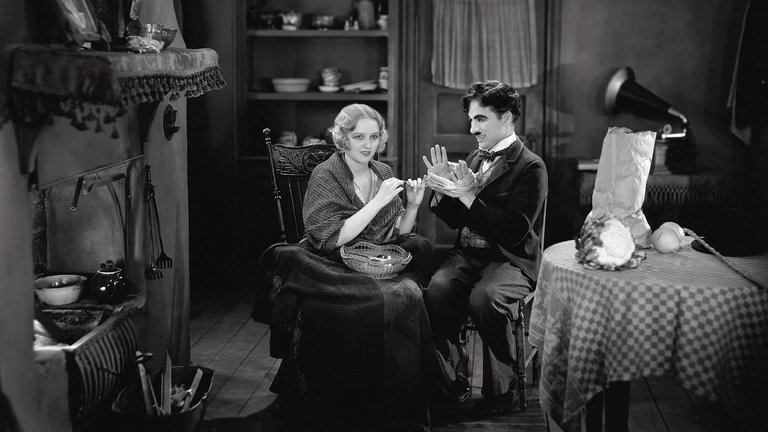Film Review: City Lights (1931)

Greatness of the great men can be seen not only through their great deeds, but also through the adversity that they had to face while achieving it. Charles Chaplin, the greatest star of silent film and the most iconic figure in the history of cinema, demonstrated his greatness through the 1931 silent comedy City Lights, considered to be his magnum opus.
Chaplin reprises his iconic character of the Tramp in the film. The plot depicts a series of the Tramp’s misadventures that lead to his encounter with a blind flower girl (played by Virginia Cherrill). He is smitten with her and falls in love, while she, due to a series of misunderstandings, believes that the Tramp is actually a millionaire. If the Tramp were indeed rich, he could have helped the flower girl and her grandmother (played by Florence Lee) evade eviction. Meanwhile, the Tramp meets an eccentric millionaire (played by Harry Myers) who wants to commit suicide by jumping into the water. The Tramp rescues him, and as a sign of gratitude, the Millionaire allows him to enjoy the luxury of his home and accompany him to wild parties. The problem for the Tramp is that his benefactor only does so when drunk and doesn’t want anything to do with the Tramp while sober. The Tramp must find a way to help the Flower Girl by himself.
Chaplin began work on City Lights in 1928, at a time when the audience, following the premiere of The Jazz Singer, began to demand sound on screen. Despite the growing popularity of sound films or "talkies," Chaplin considered them a passing fad and decided to make City Lights a silent film, which proved to be a significant risk. However, City Lights isn’t a silent film in the strictest sense. The sound was pre-recorded and featured not only some sound effects but also a memorable music score composed by Chaplin himself. The risk ultimately paid off, resulting in not only rave reviews but also excellent results at the box office, with City Lights becoming the most successful of all Hollywood films in 1931.
Chaplin's skills as a physical comedian and pantomime artist are on full display in City Lights. The film's well-choreographed and often hilarious scenes showcase Chaplin's comedic talent, honed over years of experience in silent cinema. One of the film's most memorable scenes is the boxing match, which proved to be the most challenging during production. The scene combines comedy with pathos, tragedy, and realism, firmly establishing Chaplin's iconic Tramp character in the realm of reality.
The Tramp's existential woes also serve as an opportunity for Chaplin to provide social commentary, particularly in the scene featuring the drunk Millionaire. The character, living in luxury and not having to worry about hunger like the Tramp or being expelled from home like the Flower Girl, is repeatedly prevented from committing suicide. This scene highlights the absurdity of wealth and the emptiness of material possessions.
Chaplin's performance in City Lights is exceptional, as is Virginia Cherrill's. The relationship with Chaplin during production was antagonistic, with Cherrill having little patience for Chaplin’s perfectionist way of making films. Chaplin actually had her fired from the set, but after realizing that he would have to spend too much money reshooting her scenes with another actress, he decided to re-hire her. This proved to be the right choice because she and Chaplin had great chemistry together, especially during the simple and emotional final scene that, among other things, made Alfred Einstein teary-eyed during the film’s 1931 premiere.
City Lights benefited from its long production, allowing it to be released in the early years of the Great Depression. The Wall Street Crash of 1929 put the Tramp and the film's plot in a new and relevant context. The impoverished masses were more likely to view the Tramp as one of them rather than an eccentric outsider. The film's ending, where the former "millionaire" reveals himself as a street bum, was also more in tune with the times when real millionaires suffered the same fate. Even the scene at the beginning, featuring a monument to “Prosperity” being revealed by gibberish-talking politicians (voiced by Chaplin in the first instance of his speaking on screen), which begins the film, is given new ironic meaning under the new circumstances.
City Lights became a massive hit and allowed Chaplin to continue making silent films for almost a decade. The film was instantly recognized as a masterpiece, featured prominently in prestigious Sight & Sound polls of the best films ever made, and has been named as a favorite film by many renowned directors, including Orson Welles and Andrei Tarkovsky. Its simple but believable plot, combined with Chaplin's comedic talent and likable music, make City Lights an undisputed classic that can be enjoyed by modern viewers who may not be fans of silent films.
RATING: 9/10 (+++)
Blog in Croatian https://draxblog.com
Blog in English https://draxreview.wordpress.com/
InLeo blog https://inleo.io/@drax.leo
Hiveonboard: https://hiveonboard.com?ref=drax
Rising Star game: https://www.risingstargame.com?referrer=drax
1Inch: https://1inch.exchange/#/r/0x83823d8CCB74F828148258BB4457642124b1328e
BTC donations: 1EWxiMiP6iiG9rger3NuUSd6HByaxQWafG
ETH donations: 0xB305F144323b99e6f8b1d66f5D7DE78B498C32A7
Posted using CineTV